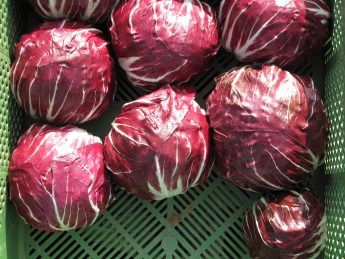You are in the mood for an Italian dish now and then, whether you want a pasta dish or risotto, or an Italian seafood dish. You want to incorporate the best Italian vegetables in the dish so you can really get an authentic experience during your meal.
When you use vegetables that are familiar to you in these Italian dishes, the experience is not as original as if you use vegetables that are part of the cuisine. That is why you want to know about the vegetables that are part of the cuisine and originate in Italy. You also want to enjoy an Italian-made salad with these vegetables.
Let’s go over the list of Italian vegetables right now.
Italian Vegetable List
Radicchio di Chioggia
Radicchio di Chioggia is a red or purple leafy vegetable originating in a small fishing port in the Venice lagoon area. The vegetable leaves have a bitter flavor, but it is high in antioxidants and other essential nutrients.
You can tame the bitter taste of Radicchio di Chioggia by adding balsamic vinegar dressing and adding some salty cheeses to it as well. Many people do love this vegetable, but it is a taste that you acquire.
You can also braise, grill, roast, and sautee it with anchovies and garlic, making it delicious. You don’t want to eat Radicchio di Chioggia raw because you will not enjoy the flavor, but you will love it if you prepare it well.
Pepperoni Cruschi
Pepperoni cruschi comes from peppers grown in the Basilicata region in Italy. These peppers are long, curvy, and red and have a sweet flavor. There is a slightly heated spicy flavor associated with it, and you prepare peperoni cruschi by properly frying it in olive oil and adding salt to them.
Then you dry the flakes in the sun as that preserves them. They become crunchy flakes, and you can enjoy pepperoni cruschi to enhance the flavor of many Italian dishes by sprinkling them on the meals, or you can eat them as a side dish.
Either way, if you prepare this vegetable well, you cannot go wrong with it at all.
Tenerumi
Another Italian vegetable is tenerumi, which is a squash-like vegetable grown in the Sicilian area. The flavor of tenerumi is nutty and has a hint of a bitter aftertaste. The best way to prepare this vegetable is to boil it and then sprinkle some olive oil.
You can also mix tenerumi with tomato sauce and pasta to give the dishes some extra flavor. You will see this vegetable used in various Sicilian dishes, and Italian restaurants in many areas of the world use this vegetable.
You will see it on the menus of these restaurants. You can find tenerumi at supermarkets too, which will allow you to prepare it and try it at home.
Radicchio Rosso di Treviso
The name of this particular Italian vegetable is a mouthful, as it is Radicchio Rosso di Treviso. You will see farmers in Venice, Padua, and Treviso grow this vegetable as it is a red leafy vegetable with some white features. Radicchio Rosso di Treviso has a bitter taste though it is considered pleasant, and it has many similarities to Radicchio di Chioggia.
The leafy vegetable is also high in nutrients and antioxidants, which is why you want to incorporate it into your diet and use it for Italian dishes you make at home.
You can enjoy raw Radicchio Rosso di Treviso, and you can also roast, grill, and braise the vegetable as well. You can enjoy it in pasta and risotto dishes, as well as fish or meat dishes. The great thing about this vegetable is that it is pretty versatile.
Cavolo Nero
Farmers in Tuscany grow cavolo nero, and it is known as Italian kale, and it is green and cabbage-like in appearance. You can use cavolo nero in soups and stews as it is best to be eaten cooked.
If you have eaten the Tuscan ribollita, you will recognize this vegetable as a staple part of that dish. Cavolo nero is also sweet in flavor and not so bitter like other types of kale that you likely tried. Additionally, the description of the taste of this vegetable is also earthy and nutty.
You will also see this vegetable included in sausage dishes, as well as with roasted bread.
Interested in finding out about the types of other vegetables and fruits? Click HERE.
Conclusion
You read the list of Italian vegetables that you have likely eaten at one time or another, even if you do not typically eat much Italian food. However, if you have been to Italian restaurants, chances are you have tried one of the vegetables listed.
If you are of Italian ancestry, perhaps your grandmother cooked you a meal that consisted of any of these Italian vegetables. However, if you want to learn how to cook Italian meals, then the primary thing to know is the vegetables incorporated in these dishes grown in Italy.
You can find them in your local grocery store, especially if it is a chain. If you decide to cook Italian dishes and incorporate these vegetables, you will love it!
Check out our website for more content like this.

